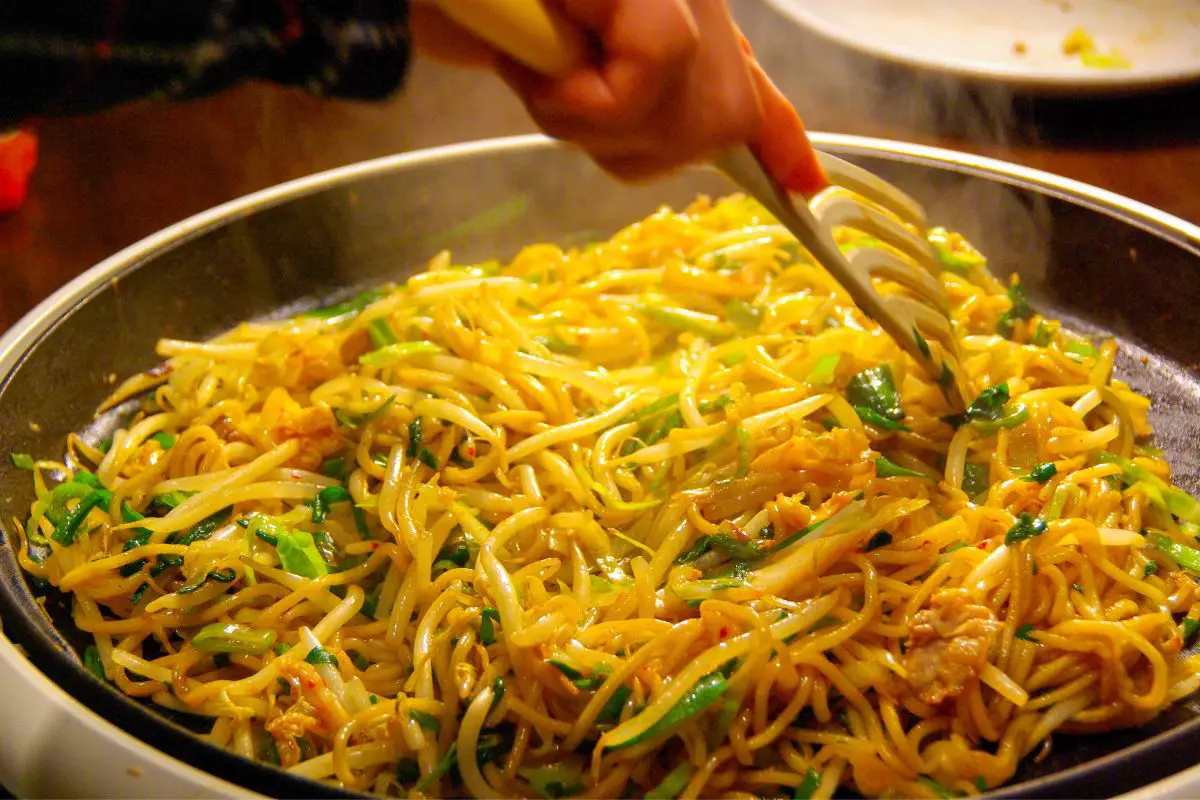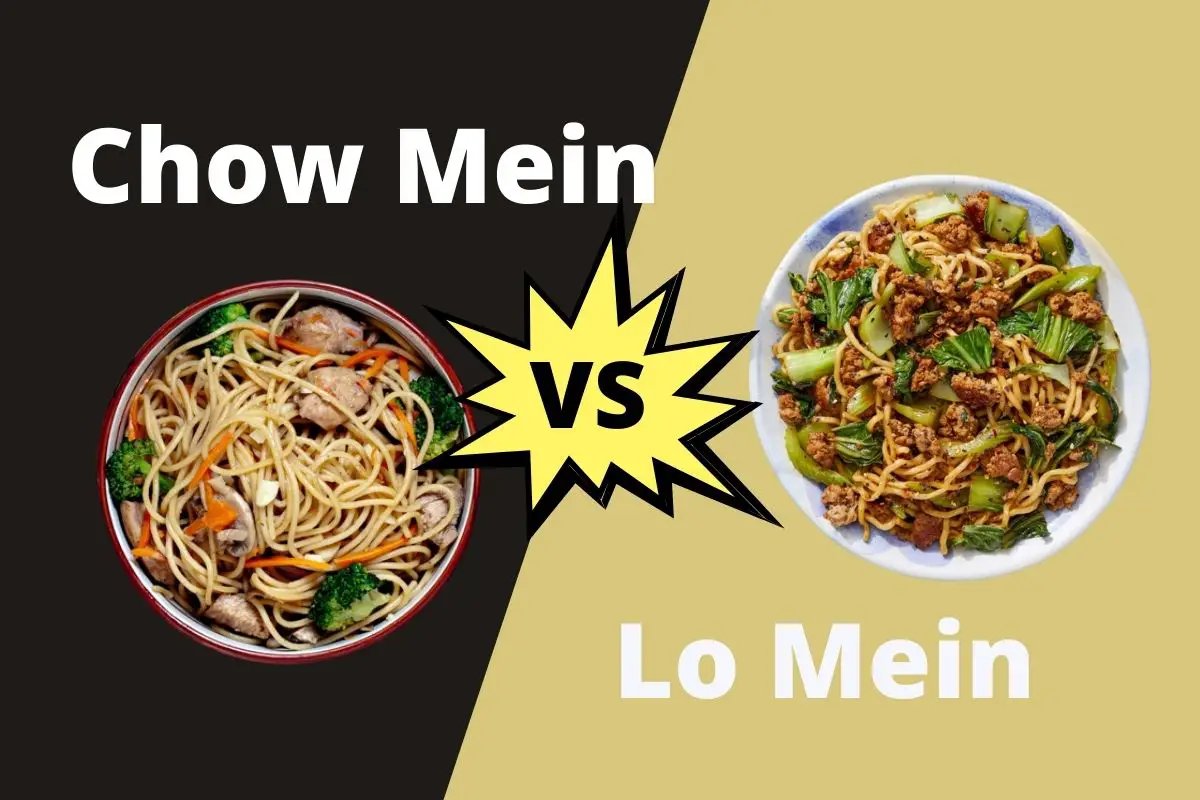The main difference between chow mein and lo mein is in the preparation. Chow mein means fried noodles, while lo mein translates to tossed or stirred noodles.
There is always confusion between the two most popular noodle-based Chinese dishes – lo mein and chow mein. While you may associate the difference with the type of noodle used in each, it’s not true.
Besides, these dishes differ in many other ways as well. Find out what exactly chow mein and lo mein are, the main differences between the two, and more.
Table of Contents
What is Chow Mein?
Chow mein is a well-known dish with noodles as the star ingredient. Initially from China, the dish gained popularity in other countries over the years, thanks to Chinese immigrants. Chow mein consists of fried noodles tossed along with various other toppings, such as diced vegetables, meat, cottage cheese, or tofu. Note that all these toppings are kept at a minimum to keep the noodles’ crunch intact.
Moreover, the sauce is added towards the end, but sparingly. Otherwise, all you would get are soggy noodles. Some modern chow mein variations are served with a thick sauce to soften the outer surface of the noodles for a chewy texture. The two most significant types of chow mein dishes are steamed chow mein and crisp chow mein.
Steamed Chow Mein
Steamed chow mein consists of deep-fried noodles sautéed with the other ingredients. The contents get tossed in a light sauce that doesn’t overpower the crispy noodles.
Crisp Chow Mein
Crisp chow mein isn’t as common as its counterpart, especially in Asian countries. Crisp chow mein includes fried noodles squeezed down to the regular pan or Chinese wok to give them a pancake look. Anything additional – toppings, sauce, or both, goes over the noodles.
Check out these clues to know whether you’re eating chow mein.
- If it’s crisp chow mein, the noodles must be crisp. Otherwise, they are oily (covered with sesame oil) and soft in steamed chow mein.
- Few veggies or protein ingredients.
- Very little sauce on the noodles

How Is Chow Mein Prepared?
Since chow mein is a stir-fried noodles dish, it’s usually prepared in the traditional Chinese wok.
Before you begin
Step 1: Soak the noodles in boiling water for a few minutes. (This process softens them before stir-frying.)
Step 2: Add some salt and oil to the hot water to prevent the noodles from sticking to each other.
Tip: Make sure not to over-cook the noodles at this stage.
Step 3: On the side, slightly sauté your protein ingredients.
Possible protein ingredients:
- Beef
- Pork
- Chicken
- Shrimp
- Tofu
Step 4: Include bean sprouts, celery, and onions with your protein. Combine the par-boiled noodles and sautéed ingredients into the wok and season them to taste.
Step 5: Mix everything for a few minutes on a medium-high flame.
Remember: Chow mein is all about the noodles rather than other ingredients. The end product must have crisp noodles covered with minimal sauce.
Lo Mein – What Is It?
If you’ve ever tried authentic soupy noodles, you’ll understand lo mein. Lo mein is similar to soupy noodles but is dryer. The lo mein noodles are thoroughly boiled, cooked with the other toppings in the traditional lo mein sauce, and served hot. For extra flavor, drizzle some soy sauce or oyster sauce on top of the cooked noodles.
Like chow mein, lo mein tastes good with vegetables and protein ingredients.
Some examples of ingredients include:
- Pork
- Chicken
- Beef
- Seafood
- Cottage cheese
- Tofu
Fun fact: In some cases, the various ingredients are sautéed separately in the sauce and transferred directly over the noodles. However, this can lead to a blander dish.
Clues that you’re eating lo mein:
- The noodles are entirely coated with lo mein sauce.
- The flavor is bold.
- The dish has a lot of protein and vegetables.

How Is Lo Mein Prepared?
Before you begin
Step 1: Thoroughly boil the noodles. Par-boiled noodles aren’t used in lo mein.
Step 2: While the noodles are boiling, sauté the other vegetables in the sauce.
Step 3: Once you’ve cooked everything, give the dish a nice toss before serving.
Note: Since lo mein is a sort of saucy noodle dish, the noodles must be soft enough and fully coated in sauce. You can also drizzle some sauce on top if required.
Chow Mein vs Lo Mein – What’s the Difference?
You’d be surprised to know how these two dishes differ despite having the same key ingredients. The next time you decide to order either of these, don’t forget to recall the following differences.
Cooking Method
The first differentiator between chow mein and lo mein is the cooking process. The noodles for lo mein are thoroughly boiled before tossing them up with the vegetables (especially bell peppers and green onions), meat, and savory lo mein sauce. Rather than stir-frying, all the ingredients get slightly tossed and mixed before serving hot.
On the other hand, the noodles for chow mein are soaked in hot water to soften them a bit. Then, the noodles are stir-fried with the remaining ingredients on a medium-high flame. This completely cooks the noodles.
Texture
The noodles used in chow mein are thinner and crunchier due to the dish’s non-saucy nature.
In lo mein, the noodles are generally soft and chewy as they’re fully boiled before being tossed with the remaining elements of the dish. Moreover, lo mein requires thicker noodles to sustain the weight of lo mein sauce.
Quantity Of Sauce Used
Another visible difference between chow mein and lo mein is the quantity of sauce used. The noodles in chow mein are covered with little to no sauce at all, as it’s generally a dry noodle dish. (Although some people prefer adding extra sauce on the top.)
On the other hand, the noodles in lo mein are entirely submerged in the vibrant and flavorful lo mein sauce to justify its saucy nature.
Nutrition
Lo mein is typically more nutritious than chow mein. This is primarily since the noodles in lo mein are never deep-fried. They are cooked in a dash of oil. Calories-wise, lo mein roughly contains half the calories present in chow mein. On the other hand, deep-fried chow mein noodles are both high in calories and fat.
Type Of Egg Noodles Used
In chow mein, you can use dried or fresh Chinese egg noodles. However, don’t use the latter if you’re preparing any lo mein dish.
While they’re both noodle-based dishes, chow mein and lo mein differ in several ways. Still, both the dishes are rockstars and a common sight in many fine-dining Chinese restaurants and bistros. Check out this table for a quick comparison of the two dishes.
Chow Mein vs Lo Mein
|
Chow Mein | vs | Lo Mein |
|
Par-boiled and then stir-fried |
Cooking Method |
Only boiled. No stir-frying is involved |
| Crisp noodles | Texture |
Soft noodles |
|
Less sauce |
Quantity of Sauce Used |
More sauce |
|
High in calories and fat |
Calories and Fat |
Low in calories and fat |
|
Fresh or dried |
Type Of Egg Noodles Used |
Always dried |
| Thick | Thickness of the noodles |
Thin |
Frequently Asked Questions
Which Is Better – Chow Mein Or Lo Mein?
If you prefer crunchy, stir-fried, dried egg noodles with less sauce, try chow mein. If you’re fond of soft and saucy noodles with not-so-crunchy vegetables, then lo mein is for you.
Can I Add More Vegetables To Chow Mein?
Chow mein is about the noodles rather than the other ingredients, including its vegetables. Thus, only add vegetables sparingly to prevent them from overpowering the noodles. If you still want more vegetables, switch to lo mein.
Which Dish is More Popular?
Chicken chow mein is the most common Chinese noodle dish prepared with wheat flour.

